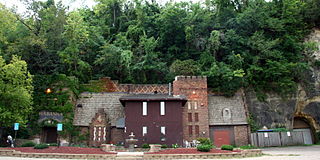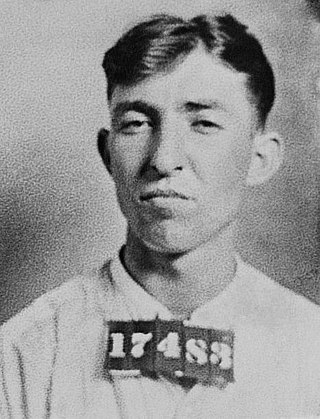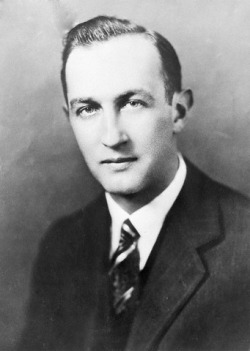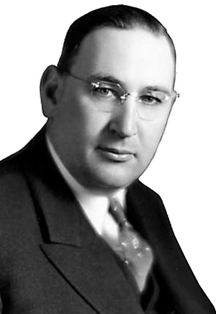Related Research Articles

Kate Barker, better known as Ma Barker, was the mother of several American criminals who ran the Barker–Karpis Gang during the "public enemy era" when the exploits of gangs of criminals in the Midwestern United States gripped the American people and press. She traveled with her sons during their criminal careers.

Isadore Blumenfeld, commonly known as Kid Cann, was a Romanian Jewish-American organized crime enforcer based in Minneapolis, Minnesota, for over four decades. He remains the most notorious mobster in the history of Minnesota. He was associated with several high-profile crimes in the city's history, including the 1924 murder of cab driver Charles Goldberg, the attempted murder of police officer James H. Trepanier, and the December 1935 assassination of investigative journalist Walter Liggett. He is also thought to have participated in the fraudulent dismantling of the Twin City Rapid Transit street railway during the early 1950s.

Alvin Francis Karpis, was a Canadian–American criminal of Lithuanian descent known for being a leader of the Barker–Karpis gang in the 1930s. Nicknamed "Creepy" for his sinister smile and called "Ray" by his gang members, Karpis led the gang along with Fred Barker and Arthur "Doc" Barker. There were only four "public enemies" ever given the title of "Public Enemy #1" by the FBI and he was the only one to be taken alive. The other three, John Dillinger, Pretty Boy Floyd, and Baby Face Nelson, were all killed before being captured. He also spent the longest time as a federal prisoner at Alcatraz Federal Penitentiary, serving twenty-six years.
"Dapper" Danny Hogan was an Irish-American organized crime figure, political fixer, and the boss of Saint Paul, Minnesota's Irish Mob both before and during Prohibition.
Westlawn Cemetery is a Jewish cemetery located in Norridge, a suburb of Chicago in Illinois. The cemetery covers 72 acres (29 ha) and roughly 46,000 people are buried there.

The Wabasha Street Caves is an event hall built into the sandstone caves located on the south shore of the Mississippi River in downtown Saint Paul, Minnesota. The caves have been home to mobsters, speakeasies, and for the past 30 years have hosted Swing Night every Thursday night with professional live Big Bands and vocalists, playing music of the old Tommy Dorsey, Glenn Miller, Count Basie, Duke Ellington Big Bands. Dances are open to the public and draw crowds in the hundreds. The Wabasha Street Caves also provide historical tours and Murder Mystery Tours in these sandstone caves in Saint Paul, Minnesota near the Mississippi River.[2] Moonlight Serenaders Big Band

Homer Virgil Van Meter was an American criminal and bank robber active in the early 20th century, most notably as a criminal associate of John Dillinger and Baby Face Nelson.

Joseph P. Moran (1895–1934) was an American medical doctor known for catering to the Depression-era criminal underworld in the early 20th century. He was also a peripheral member of the Barker-Karpis gang, and was possibly the last physician to see the mortally wounded John Hamilton, a member of the John Dillinger gang, whom Moran refused to treat.
Edna "Rabbit" Murray (1898–1966) was a criminal associated with several high-profile gangs in the Depression-era of the early 1930s. Although popularly known to the press as the "Kissing Bandit" for kissing a male robbery victim, she was known in the underworld as "Rabbit" for her skills in breaking out of the penitentiary.
Fred Samuel Goetz, also known as "Shotgun" George Ziegler, was a Chicago Outfit mobster and a suspected participant in the Saint Valentine's Day Massacre, in 1929.

Arthur Raymond "Doc" Barker was an American criminal, the son of Ma Barker and a member of the Barker-Karpis gang, founded by his brother Fred Barker and Alvin Karpis. Barker was typically called on for violent action, while Fred and Karpis planned the gang's crimes. He was arrested and convicted of kidnapping in 1935. Sent to Alcatraz Federal Penitentiary in 1936, he was killed three years later while attempting to escape.

St. Paul's historic Landmark Center, completed in 1902, originally served as the United States Post Office, Courthouse, and Custom House for the state of Minnesota. It was designed by Willoughby J. Edbrooke, who served as Supervising Architect of the U.S. Treasury Department in 1891–92. Edbrooke designed a body of public architecture, much of which, like this structure, was completed after his 1896 death. Landmark Center stands at 75 West Fifth Street in Rice Park and is now an arts and culture center.

Volney Everett "Curley" Davis was an American bank robber and Great Depression-era outlaw. A longtime Oklahoma bandit, he was the boyfriend of Edna Murray and an associate of both the John Dillinger and Alvin Karpis-Barker gangs during the 1930s.

Harold Eugene "Eddie" Green was an American bank robber and Depression-era outlaw during the 1930s, best known as a member of the John Dillinger gang. He was also associated with Frank "Jelly" Nash, Volney Davis and the Barker-Karpis Gang in his early career.

Herbert Allen Farmer, was an American criminal who, with his wife Esther, operated a safe house for underworld fugitives from the mid-1920s to 1933.

Frederick George Barker was an American criminal who, along with Alvin Karpis, co-founded the Barker-Karpis gang, which committed numerous robberies, murders and kidnappings during the 1930s. Barker was the youngest son of Ma Barker, all of whose children were criminals. He was killed in a lengthy gunfight with the Federal Bureau of Investigation (FBI) in 1935.

The kidnapping of Edward Bremer was the last major criminal enterprise of the Barker-Karpis gang. Though successful in netting the gang a large ransom, it brought down the full force of the FBI on the gang, resulting in the death or capture of its main members in the months afterwards. The kidnapping was ordered by St. Paul Jewish-American organized crime boss Harry Sawyer, and carried out by Fred Barker, Alvin Karpis, Arthur Barker, Volney Davis and Chicago Outfit mobster George Ziegler.

The Barker–Karpis Gang was one of the longest-lived criminal gangs during the Depression Era, spanning from 1931 to 1935. The gang was founded by Fred Barker and Alvin Karpis, and later joined by Fred's brother Arthur "Doc" Barker. Along with the three core members, the gang's network spanned up to 25 members at one point.

Thomas Archibald Brown, also known as Big Tom, was an American law enforcement official who served as chief of the Saint Paul Police Department (SPPD) during the Great Depression and was notorious for engaging in flagrant corruption.
Leon Gleckman was a Belarusian Jewish immigrant to the United States. Gleckman rose to prominence as a bootlegger during Prohibition and as a leader within what has come to be known as Jewish-American organized crime. So great was his power that Gleckman was eventually dubbed, "The Al Capone of Saint Paul."
References
- ↑ Paul Maccabee (1993), John Dillinger Slept Here: A Crook's Tour of Crime and Corruption in St. Paul, 1920-1936, Minnesota Historical Society Press. Pages 62-63.
- ↑ Tim Mahoney (2013), pages 175-178.
- ↑ Paul Maccabee (1993), John Dillinger Slept Here: A Crook's Tour of Crime and Corruption in St. Paul, 1920-1936, Minnesota Historical Society Press. Pages 284.
- ↑ Paul Maccabee (1993), John Dillinger Slept Here: A Crook's Tour of Crime and Corruption in St. Paul, 1920-1936, Minnesota Historical Society Press. Pages 284-285.
- ↑ Paul Maccabee (1993), John Dillinger Slept Here: A Crook's Tour of Crime and Corruption in St. Paul, 1920-1936, Minnesota Historical Society Press. Pages 284.